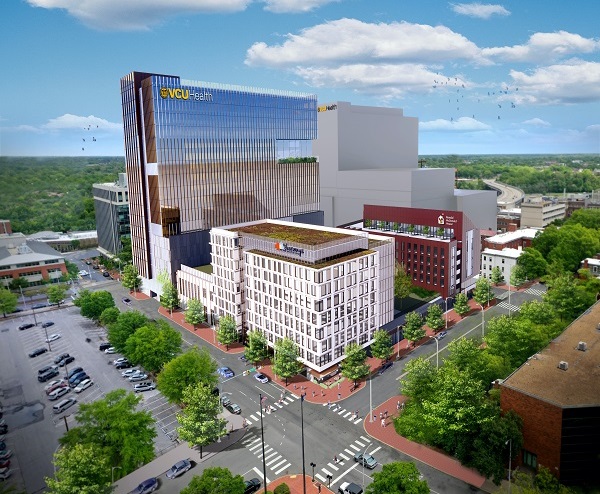
A rendering of the taller version of the project to replace the Public Safety Building. (File image courtesy Capital City Partners)
The doomed downtown development that has ended up costing VCU Health at least $80 million to exit appears to have been ill-fated nearly from the start.
When the developer behind the $325 million project to replace Richmond’s old Public Safety Building filed a scaled-down version of its plan last year, the city responded three weeks later with a notice of default that was unwavering in its demands to see the original project through, as shown in documents obtained through Freedom of Information Act requests.
Instead of 17 stories, the city noted, the tower was now shown to be seven stories tall. Instead of office space for VCU Health and additional spec space, the plan now involved research space. Instead of a minimum of 1,200 structured parking spaces, 200 of which were to be made available for city use, the new plan showed only 600.
On top of that, the notice said, developer Capital City Partners had not informed the city, as their development agreement required, of any issues facing the project until that February. That was three months after the developer had first alerted VCU Health to those concerns, the city said.
The alternative plan of development, the April 7 notice stated, “in no way constitutes a POD application for the project as it relates to the development agreement” – referring to the deal the city struck a year earlier with CCP to build the multi-building complex with a high-rise office tower to be leased by VCU Health.
The notice concluded: “…though Developer became aware of concerns regarding its ability to complete the project in November 2021 or sooner, not only did the Developer fail to promptly inform the City of such ‘material issue or problem,’” but CCP’s quarterly report to the city, submitted a month later, stated the project was on track with no issues.
The formal response, from Chief Administrative Officer Lincoln Saunders and copied to top city and VCU Health officials, belied an apparent breakdown between the three parties that had been brewing for months, communications show.
The following day, Susan Eastridge, one of CCP’s principals along with Michael Hallmark, told Saunders in an email they were “disheartened” to receive the default notice. Eastridge maintained that they had been discussing with him and other city officials since January how to go about amending the agreement, in light of unforeseen challenges with the project site and the market changes that came with the pandemic.
“As you know from these updates and many others, we fully acknowledge that the program we are discussing now has some changes to it. These are not capricious changes on our end, but thoroughly vetted issues brought about solely because of the devastating global economic impacts that began to crescendo during 2021, and then hit the project fully at the end of 2021,” Eastridge wrote.
“Once the consequences of those impacts were fully understood by our development team, and also by our tenants, we then brought the problem, and what we believed was a solution, to your attention,” she said.
The rise of remote working had revealed a need to change the project from primarily office space to research space. While more expensive to build, Eastridge said such space was “booming across the country” and “a use that Richmond so desperately needs,” in keeping with the city’s vision for that part of downtown as a so-called innovation district.
“Your letter ignores the significant efforts of CCP to overcome these profound market obstacles to the Project, as well as the undocumented site conditions we have inherited with the Public Safety Building,” Eastridge wrote. “Your letter instead articulates only the City’s desire to return to pre-pandemic conditions that have shifted everywhere else in the world, including Richmond.”
Her letter concluded: “Given these facts, the delivery of a default letter midstream during good faith communications towards a mutually agreed amendment is very confusing to us. It’s also not helpful to the City’s interest, unless those interests are stagnant economic progress.”
The exchange signals a drawing of lines between the parties that ultimately led to the project’s demise, to VCU Health backing out of the project at a cost known so far to have reached $80 million, and to a heightening scrutiny of the original deal that’s come to include an underway VCU-driven review.
Third-party review ordered
VCU, the university, and VCU Health System are overseeing a review of the original deal, which put the health system on the hook for over a half billion dollars of rent over 25 years. It also hooked VCU Health into real estate tax payments to the city that are ongoing, and ultimately for a $73 million payment to break its lease and back out of the project.
A third-party law firm is conducting the review, said VCU spokesman Grant Heston. The review was initiated by Michael Rao, president of both VCU and VCU Health.
In a statement to BizSense, Heston said: “President Rao has appointed a special committee of board members to report to the VCU Health Board of Directors and VCU Board of Visitors to review what took place and develop best practice recommendations for the future. The committee is working with an independent third-party law firm to complete the review this summer.”
The original deal was memorialized through a multi-party agreement signed in July 2021. It was signed on VCU Health’s behalf by previous CEO Art Kellermann, alongside signatures from CCP’s Eastridge and from James Hennessey, a principal at Oak Street Real Estate Capital, one of CCP’s main investors in the deal and the project’s landlord in an LLC with Mesirow Financial. Oak Street is now a division of New York-based Blue Owl Capital.
Attorneys who consulted on the agreement were Dan Campbell with Hunton Andrews Kurth on behalf of VCU Health; Roth Jackson’s Mark Kronenthal and Jennifer Mullen for CCP; and David Rosenberg with Kirkland & Ellis in Chicago for the landlord LLC.
Kronenthal, now an independent practitioner, and Mullen had also represented Eastridge and Hallmark on the unsuccessful Navy Hill project, the mixed-use development plan that would have replaced the Richmond Coliseum and involved the Public Safety Building site at 500 N. 10th St.
Kellermann, who joined VCU Health in October 2020, was less than a year on the job when that agreement was signed, and had come on months after the project was proposed. He resigned last November at the request of President Rao, according to a statement from Kellermann that accompanied an announcement from Rao of the leadership change. The announcement did not specify a reason for the change.
The review adds to increasing scrutiny of the original deal, including a call from former Virginia Gov. Doug Wilder – a VCU professor and namesake of the university’s L. Douglas Wilder School of Government and Public Affairs – for a state investigation into the $73 million payment and for the Board of Visitors to fire Rao.
City ‘expects to be made whole’
For their part, the project’s demise cost Eastridge and Hallmark the full contract for their work. While VCU Health’s $73 million payment was made through a defeasance agreement with the landlord LLC and UMB Bank, CCP was not a party to that agreement.
By last August, when a draft of the defeasance agreement was being circulated, CCP sought payment of its developer and project management fees since April, as well as a $391,500 developer fee retainage and $1.16 million in underwriting and financing costs.
According to the project budget, CCP was to have been paid $11 million in developer fees and $5.5 million in project management fees over the course of the nearly four-year project.
CCP’s request was denied in a letter from an attorney for VCU Health, which was paying CCP via draws from the landlord allowance. The Aug. 18 letter from Kenneth Jacob with ArentFox Schiff in D.C. stated: “…these amounts can only be earned by Developer upon completion of an on time at or under budget Project, which is an impossibility.”
Weeks earlier, on June 30, roughly two months after the first default notice was sent, the city sent CCP a notice of additional default – this one for failing to submit a demolition permit on time, and for failing to remit that year’s guaranteed obligation payment: annual payments to the city intended to cover the minimum real estate tax revenue that the project was anticipated to generate.
A similar failure-to-remit notice was sent to VCU Health, which put the blame for the missed payment on CCP. The health system said the developer had access to the project budget escrow to make the payments for VCU Health and had the authority to do so where the health system did not, based on how the process was set up in the financing and payment draws.
The payment was later made, documents state. But the fate of the project seemed to be sealed.
A series of meetings between the parties – minus their legal counsels – were convened over the following weeks. The initial meeting’s goal, as Richmond Economic Development Director Leonard Sledge said in an email, was to “discuss the path forward to redevelop the Public Safety Building site.”
But by mid-August, the wind-down process was underway. The draft defeasance agreement was making the rounds to allow the parties to walk away from the project free from litigation and allowed the health system to back out of its lease with the $73 million payment to unwind the loan.
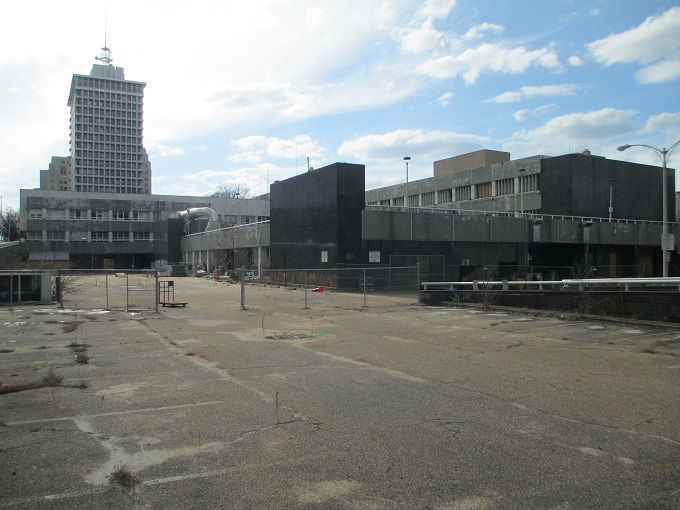
The Public Safety Building site at Leigh and 10th streets, a block away from City Hall. (BizSense file photos)
The onetime payment turned out to be just part of the overall cost to VCU Health to back out of the project. As part of its exit arrangement, VCU Health agreed to go through with demolishing the 69-year-old Public Safety Building, at an estimated cost of $5 million. It also committed to continue the guaranteed obligation payments, the third of which is due June 5 and would bring the total paid thus far to nearly $2 million.
The city’s additional default notice to CCP noted other obligations it intended see through from the developer, including the 200 structured parking spaces – or their monetary equivalent – that were to be made available for use by city and non-VCU Health users. The city also wanted from CCP a $500,000 investment over five years to create a fund to support small businesses leasing space in the development, student scholarships, and other forms of community assistance.
“Should the Project not move forward as set forth in the Development Agreement,” the notice states, “the City will suffer damages as a direct result of the failure of the Project and expects to be made whole.”
The guaranteed obligation payments also mentioned in that notice and the one sent to VCU Health increase annually, reaching just under $3 million for the final tax year, 2045. If paid out completely, the 25 payments would total nearly $56 million paid to the city. VCU Health has said it would continue to make the payments until the city conveys the site for future development to a new owner.
That new owner could end up being VCU, the university, which has said it is now pursuing a new and more expensive project for the site: a $415 million development to house its planned VCU Dentistry Center.

A rendering of the taller version of the project to replace the Public Safety Building. (File image courtesy Capital City Partners)
The doomed downtown development that has ended up costing VCU Health at least $80 million to exit appears to have been ill-fated nearly from the start.
When the developer behind the $325 million project to replace Richmond’s old Public Safety Building filed a scaled-down version of its plan last year, the city responded three weeks later with a notice of default that was unwavering in its demands to see the original project through, as shown in documents obtained through Freedom of Information Act requests.
Instead of 17 stories, the city noted, the tower was now shown to be seven stories tall. Instead of office space for VCU Health and additional spec space, the plan now involved research space. Instead of a minimum of 1,200 structured parking spaces, 200 of which were to be made available for city use, the new plan showed only 600.
On top of that, the notice said, developer Capital City Partners had not informed the city, as their development agreement required, of any issues facing the project until that February. That was three months after the developer had first alerted VCU Health to those concerns, the city said.
The alternative plan of development, the April 7 notice stated, “in no way constitutes a POD application for the project as it relates to the development agreement” – referring to the deal the city struck a year earlier with CCP to build the multi-building complex with a high-rise office tower to be leased by VCU Health.
The notice concluded: “…though Developer became aware of concerns regarding its ability to complete the project in November 2021 or sooner, not only did the Developer fail to promptly inform the City of such ‘material issue or problem,’” but CCP’s quarterly report to the city, submitted a month later, stated the project was on track with no issues.
The formal response, from Chief Administrative Officer Lincoln Saunders and copied to top city and VCU Health officials, belied an apparent breakdown between the three parties that had been brewing for months, communications show.
The following day, Susan Eastridge, one of CCP’s principals along with Michael Hallmark, told Saunders in an email they were “disheartened” to receive the default notice. Eastridge maintained that they had been discussing with him and other city officials since January how to go about amending the agreement, in light of unforeseen challenges with the project site and the market changes that came with the pandemic.
“As you know from these updates and many others, we fully acknowledge that the program we are discussing now has some changes to it. These are not capricious changes on our end, but thoroughly vetted issues brought about solely because of the devastating global economic impacts that began to crescendo during 2021, and then hit the project fully at the end of 2021,” Eastridge wrote.
“Once the consequences of those impacts were fully understood by our development team, and also by our tenants, we then brought the problem, and what we believed was a solution, to your attention,” she said.
The rise of remote working had revealed a need to change the project from primarily office space to research space. While more expensive to build, Eastridge said such space was “booming across the country” and “a use that Richmond so desperately needs,” in keeping with the city’s vision for that part of downtown as a so-called innovation district.
“Your letter ignores the significant efforts of CCP to overcome these profound market obstacles to the Project, as well as the undocumented site conditions we have inherited with the Public Safety Building,” Eastridge wrote. “Your letter instead articulates only the City’s desire to return to pre-pandemic conditions that have shifted everywhere else in the world, including Richmond.”
Her letter concluded: “Given these facts, the delivery of a default letter midstream during good faith communications towards a mutually agreed amendment is very confusing to us. It’s also not helpful to the City’s interest, unless those interests are stagnant economic progress.”
The exchange signals a drawing of lines between the parties that ultimately led to the project’s demise, to VCU Health backing out of the project at a cost known so far to have reached $80 million, and to a heightening scrutiny of the original deal that’s come to include an underway VCU-driven review.
Third-party review ordered
VCU, the university, and VCU Health System are overseeing a review of the original deal, which put the health system on the hook for over a half billion dollars of rent over 25 years. It also hooked VCU Health into real estate tax payments to the city that are ongoing, and ultimately for a $73 million payment to break its lease and back out of the project.
A third-party law firm is conducting the review, said VCU spokesman Grant Heston. The review was initiated by Michael Rao, president of both VCU and VCU Health.
In a statement to BizSense, Heston said: “President Rao has appointed a special committee of board members to report to the VCU Health Board of Directors and VCU Board of Visitors to review what took place and develop best practice recommendations for the future. The committee is working with an independent third-party law firm to complete the review this summer.”
The original deal was memorialized through a multi-party agreement signed in July 2021. It was signed on VCU Health’s behalf by previous CEO Art Kellermann, alongside signatures from CCP’s Eastridge and from James Hennessey, a principal at Oak Street Real Estate Capital, one of CCP’s main investors in the deal and the project’s landlord in an LLC with Mesirow Financial. Oak Street is now a division of New York-based Blue Owl Capital.
Attorneys who consulted on the agreement were Dan Campbell with Hunton Andrews Kurth on behalf of VCU Health; Roth Jackson’s Mark Kronenthal and Jennifer Mullen for CCP; and David Rosenberg with Kirkland & Ellis in Chicago for the landlord LLC.
Kronenthal, now an independent practitioner, and Mullen had also represented Eastridge and Hallmark on the unsuccessful Navy Hill project, the mixed-use development plan that would have replaced the Richmond Coliseum and involved the Public Safety Building site at 500 N. 10th St.
Kellermann, who joined VCU Health in October 2020, was less than a year on the job when that agreement was signed, and had come on months after the project was proposed. He resigned last November at the request of President Rao, according to a statement from Kellermann that accompanied an announcement from Rao of the leadership change. The announcement did not specify a reason for the change.
The review adds to increasing scrutiny of the original deal, including a call from former Virginia Gov. Doug Wilder – a VCU professor and namesake of the university’s L. Douglas Wilder School of Government and Public Affairs – for a state investigation into the $73 million payment and for the Board of Visitors to fire Rao.
City ‘expects to be made whole’
For their part, the project’s demise cost Eastridge and Hallmark the full contract for their work. While VCU Health’s $73 million payment was made through a defeasance agreement with the landlord LLC and UMB Bank, CCP was not a party to that agreement.
By last August, when a draft of the defeasance agreement was being circulated, CCP sought payment of its developer and project management fees since April, as well as a $391,500 developer fee retainage and $1.16 million in underwriting and financing costs.
According to the project budget, CCP was to have been paid $11 million in developer fees and $5.5 million in project management fees over the course of the nearly four-year project.
CCP’s request was denied in a letter from an attorney for VCU Health, which was paying CCP via draws from the landlord allowance. The Aug. 18 letter from Kenneth Jacob with ArentFox Schiff in D.C. stated: “…these amounts can only be earned by Developer upon completion of an on time at or under budget Project, which is an impossibility.”
Weeks earlier, on June 30, roughly two months after the first default notice was sent, the city sent CCP a notice of additional default – this one for failing to submit a demolition permit on time, and for failing to remit that year’s guaranteed obligation payment: annual payments to the city intended to cover the minimum real estate tax revenue that the project was anticipated to generate.
A similar failure-to-remit notice was sent to VCU Health, which put the blame for the missed payment on CCP. The health system said the developer had access to the project budget escrow to make the payments for VCU Health and had the authority to do so where the health system did not, based on how the process was set up in the financing and payment draws.
The payment was later made, documents state. But the fate of the project seemed to be sealed.
A series of meetings between the parties – minus their legal counsels – were convened over the following weeks. The initial meeting’s goal, as Richmond Economic Development Director Leonard Sledge said in an email, was to “discuss the path forward to redevelop the Public Safety Building site.”
But by mid-August, the wind-down process was underway. The draft defeasance agreement was making the rounds to allow the parties to walk away from the project free from litigation and allowed the health system to back out of its lease with the $73 million payment to unwind the loan.

The Public Safety Building site at Leigh and 10th streets, a block away from City Hall. (BizSense file photos)
The onetime payment turned out to be just part of the overall cost to VCU Health to back out of the project. As part of its exit arrangement, VCU Health agreed to go through with demolishing the 69-year-old Public Safety Building, at an estimated cost of $5 million. It also committed to continue the guaranteed obligation payments, the third of which is due June 5 and would bring the total paid thus far to nearly $2 million.
The city’s additional default notice to CCP noted other obligations it intended see through from the developer, including the 200 structured parking spaces – or their monetary equivalent – that were to be made available for use by city and non-VCU Health users. The city also wanted from CCP a $500,000 investment over five years to create a fund to support small businesses leasing space in the development, student scholarships, and other forms of community assistance.
“Should the Project not move forward as set forth in the Development Agreement,” the notice states, “the City will suffer damages as a direct result of the failure of the Project and expects to be made whole.”
The guaranteed obligation payments also mentioned in that notice and the one sent to VCU Health increase annually, reaching just under $3 million for the final tax year, 2045. If paid out completely, the 25 payments would total nearly $56 million paid to the city. VCU Health has said it would continue to make the payments until the city conveys the site for future development to a new owner.
That new owner could end up being VCU, the university, which has said it is now pursuing a new and more expensive project for the site: a $415 million development to house its planned VCU Dentistry Center.
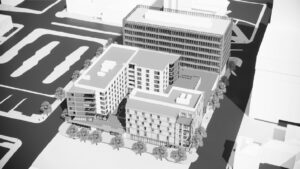
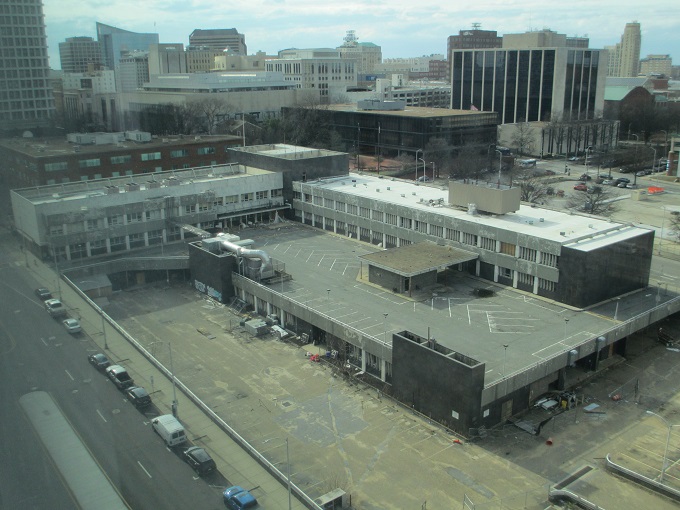
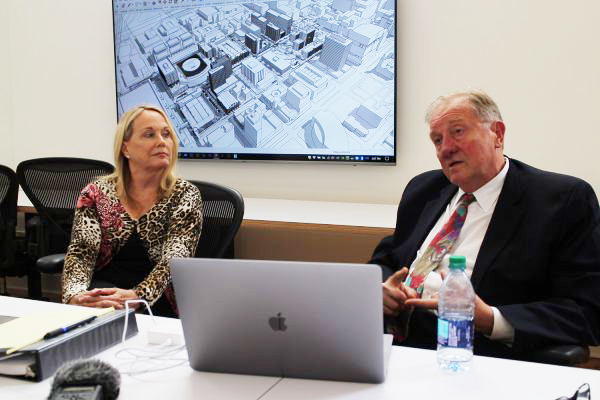
Richmond city blames everyone else,CCP blames
pandemic. VCU health and taxpayers get
stuck with all the bills! Things will always
end up “FUNNY” when Richmond city is
involved!
This is terrific reporting. Thank you. If the new owner of the site does happen to be VCU Health, I hope the city works to recoup or otherwise achieve the property tax revenue that was projected in this initial development.
Thank you so much for this excellent series of investigative and informative articles! Kudos RBS and Jonathan Spiers.
As you may recall, the development first ran aground when it was uncovered, after some months, that the negotiator for the Developer was the nephew of the City’s CEO who was in charge of the negotiation for the City. This development process has been messy since day one.
Everyone might also recall this was the group that was going to be a major player in Navy Hill project too. I can only imagine what a disaster that would be at this stage in its process if it had been approved. Good luck Henrico with Green City; read those agreements and get some good Counsel.
I’m hoping Jonathan @ BizSense confronts Henrico about their commitments to CCP, and Eastridge and Hallmark. Will Eastridge and Hallmark attempt to recoup their losses on the backs of Henrico taxpayers?
Henrico has always been better run, and had better lawyers than Richmond.
looks like VCU was hornswoggled and their management was incompetent. thanks for naming the folks responsible for this shambolic deal and the perps. watch out Henrico
Code Blue Calling Dr. Rao Code Blue
Dr. Rao is neither a physician or a Doctor of any academic subject — he basically has a professional management degree sort of like a Masters in Educational Leadership that many people who want to administrate in local public school systems get, except this one seems to be for those who want to lead colleges without a lot of academic prestige.
Now do the same with the 500,000 missing lap top charges and Mr. Russo’s slush fund
Finally a reporter is asking questions and getting hopefully someone fired
John V. Henrico county manager. Knowing you, I trust
that you have not allowed CCP to take advantage of the
county. I think you might want to issue a release to assure
the Henrico taxpayers. What happened to VCU health is very
distressing! Give it some thought John.
Vithoulkas – be transparent that is all we ask. You may take a bunch of s@#t, but I say off with the head, don’t die of a thousand cuts.
All that can be said is that this was a complete SNAFU from the start. Wilder is correct the JLARC needs to conduct a thorough investigation of this entire transaction. CCP can say they’re out something but not anything which was earned as far as I can tell. Good luck to Henrico and Green City with Eastridge and Hallmark on that one also (I wouldn’t trust them to develop a dog kennel).
The thing is, if Richmond had put Navy Hill up for auction to the highest bidder that whole area would be a forest of construction cranes. But the city and its mayors always want to stick their thumbs on the scales to help their “friends.”
GREAT journalism but the details are a hall of mirrors. I often think myself that it is City Hall’s goal to stymie economic growth– it can’t ALL be incompetence!
I wonder why they stonewalling the developer and I begin to wonder WHY VCUH had to pay up if the whole thing was falling apart.